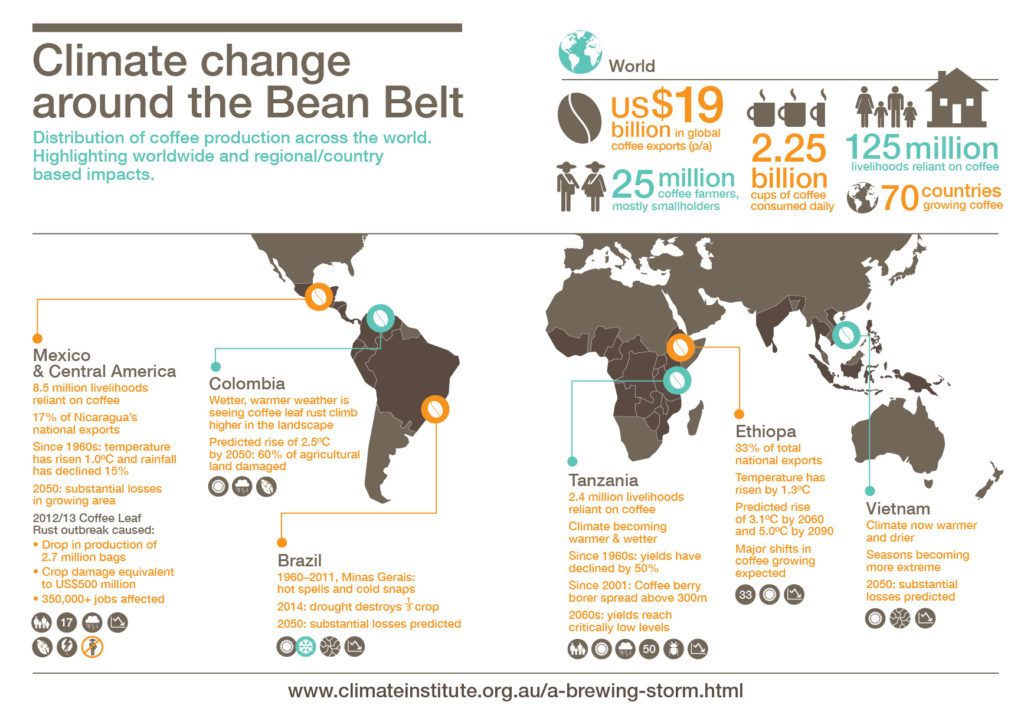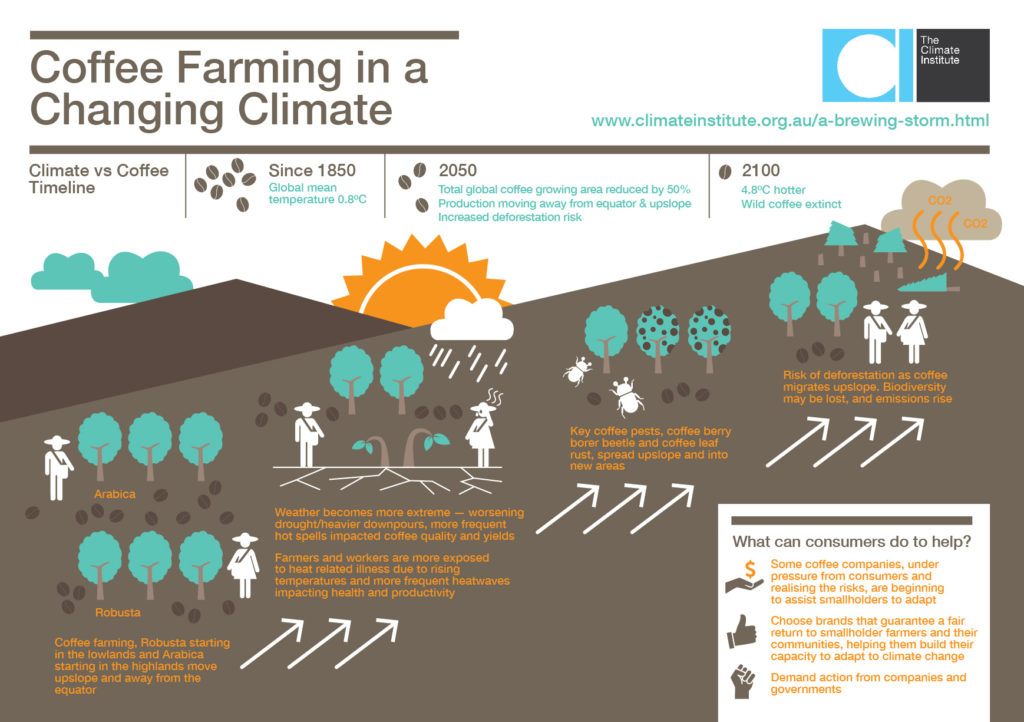A Coffee-less world

No morning stimulant. No late night caffeine fueled marathons to meet deadlines. People meeting for "Coke" or "Red bull"? This is a coffee less world.
Imagine a morning where you couldn’t drink coffee. What were you feeling – irritable? On-the-edge? And what did you feel when you finally had some coffee? Relief? More than 2.25 billion cups of coffee are consumed each day worldwide. [1] So, irrespective of whether you feel caffeine addiction is good or bad, it is clear that the world runs on caffeine. Coffee is so freely available that we take it for granted. However, climate change could wipe out coffee production entirely in the future and is a major issue for companies such as Starbucks.
The main coffee growing countries are Colombia, Mexico, Ethiopia, Vietnam, and Brazil, collectively referred as the “Bean Belt”. [2] Increasing temperatures worldwide could reduce the land area suitable for coffee by 50% by 2050 and could wipe out coffee altogether by 2080. [3] Warmer temperatures, increased pest and fungus incidence, and pressure on farmers are likely to severely affect the coffee supply chain.[4]

1) High sensitivity to temperature:
Starbucks sells Arabica Coffee, a highly temperature sensitive higher grade of coffee that comprises about 70% of the coffee sold worldwide.[5] The optimum temperature for it is 18-21°C and when temperatures exceed this range significantly for a prolonged period of time, the plant health deteriorates rapidly and the bean gets spoiled.[6] Thus, with increasing temperatures Starbucks is likely to face major bean shortages in the future.
2) Pests and fungus:
Another major issue is pest infestation and fungal infections called coffee rust.[7] A troublesome pest is the coffee berry borer, which is not sensitive to pesticides and can spoil coffee beans and cause hundreds of millions of dollars’ worth of damage.[8] Even small rises in temperature of 1-2°C can lead in the widespread proliferation of the coffee berry borer at higher altitudes where coffee is grown, significantly damaging the crop.[9] Compounding the pest infestation problem, in 2011, higher temperatures and heavy rainfall at high altitudes also led to significant proliferation of coffee rust (earlier seen only at lower altitudes) in Central America, which wiped out about 50% of coffee producing land area. [10]
3)Pressure on the livelihood of coffee farmers:
About 25 million people worldwide are engaged in coffee farming[11]. Climate change forces farmers to move to higher elevations to be able to grow coffee, but coffee plants take 3-4 years for the beans to be harvest ready[12], a length of time that farmers may not be go without any income. Experiencing difficulties with coffee, farmers may be compelled to completely switch to other crops.[13] This would cause more problems for Starbucks’ supply chain.
Steps taken by Starbucks to deal with climate change:
- Starbucks has established standards and processes called Coffee and Farmer Equity Practices (C.A.F.E)[14] to promote effective agricultural practices that help deal with higher temperatures through the use of shade and tree conversation. [15]
- In 2013, Starbucks invested in a laboratory in Costa Rica to identify optimal ways to increase coffee yield at higher temperatures. [16]
- In Mexico, Starbucks developed and distributed 20 million coffee rust-resistant coffee seedlings to farmers whose crops had been damaged. [17]
- At a broader level, Starbucks is working on two initiatives. It helped co-found BICEP, an initiative that helps raise awareness about climate change and supports policies aimed at curbing the impact of climate change.[18] Furthermore, Starbucks is working with Conservation International to identify ways it could aid farmers including helping severely affected farmers grow crops other than coffee, even though it seems counterproductive, to reduce the reliance on coffee as a whole.[19] Without this support, the farmers may not be able to crow any crop at all.

My Recommendations:
1)Starbucks could study the genetic makeup of various Arabica coffee strains in the wild, especially in Ethiopia, where more than 95% of Arabic’s genetic diversity is present, and isolate and grow the strains that are less sensitive to high temperatures. [20] This task can be done quicker now given by the fact that in 2014, the Inter-American Development Bank identified and published the entire DNA sequence of the Arabica variant.[21]
2)Starbucks could also try to devise strategies to deal with various pests including the coffee berry borer, which caused significant financial damage.
3)Starbucks could also financially aid the farmers to move to higher altitudes, where the impacts of increasing temperatures are less detrimental to the coffee plant. [22] The coffee plant takes a few years to harvest, so farmers who move will need to have some source of income during this in between period. Increasing the adaptive capability of farmers should be the main focus.
What else could Starbucks do – Source beans from other countries? Switch to less-temperature sensitive Robusta Coffee?
[Word count without citations: 794]
Citations:
[1] National Oceanic and Atmospheric Administration, Michon Scott, 2015: https://www.climate.gov/news-features/climate-and/climate-coffee
[2] http://www.nytimes.com/2016/09/23/science/climate-change-threatens-worlds-coffee-supply-report-says.html
[3]The Climate Institute, “A Brewing Storm: The climate change risks to coffee” (2016): http://fairtrade.com.au/~/media/fairtrade%20australasia/files/resources%20for%20pages%20-%20reports%20standards%20and%20policies/tci_a_brewing_storm_final_24082016_web.pdf
[4] IBID
[5]IBID
[6] National Oceanic and Atmospheric Administration, Michon Scott, 2015: https://www.climate.gov/news-features/climate-and/climate-coffee
[7] http://www.starbucks.com/responsibility/environment/climate-change
[8] http://www.nytimes.com/2016/09/23/science/climate-change-threatens-worlds-coffee-supply-report-says.html
[9] National Oceanic and Atmospheric Administration, Michon Scott, 2015: https://www.climate.gov/news-features/climate-and/climate-coffee
[10] IBID
[11] Fair Trade America: http://www.fairtradeamerica.org/en-us/farmers-and-workers/coffee
[12] National Coffee Association USA – http://www.ncausa.org/About-Coffee/10-Steps-from-Seed-to-Cup
[13] https://munchies.vice.com/en/articles/half-the-worlds-coffee-growing-regions-could-be-gone-by-2050
[14] http://www.starbucks.com/responsibility/environment/climate-change
[15] http://www.starbucks.com/responsibility/sourcing/coffee
[16] IBID
[17] https://www.technologyreview.com/s/601404/starbucks-responds-to-climate-change-with-mixed-results/
[18] http://www.starbucks.com/responsibility/environment/climate-change
[19] Thorpe, Jodie, and Shelly Fennell. “Climate Change Risks and Supply Chain Responsibility: How should companies respond when extreme weather affects small-scale producers in their supply chain?.” Oxfam Policy and Practice: Private Sector 9, no. 1 (2012): 39-62.
[20] National Oceanic and Atmospheric Administration, Michon Scott, 2015: https://www.climate.gov/news-features/climate-and/climate-coffee
[21] IBID
[22] Ramirez-Villegas, Julian, Mike Salazar, Andy Jarvis, and Carlos E. Navarro-Racines. “A way forward on adaptation to climate change in Colombian agriculture: perspectives towards 2050.” Climatic Change 115, no. 3-4 (2012): 611-628.
Source for Fig1 and Fig2: https://climatecare.org/wordpress/wp-content/uploads/2016/09/A-Brewing-Storm-The-climate-change-risks-to-coffee.pdf
Source for main cover image: http://ichef-1.bbci.co.uk/news/624/media/images/82776000/jpg/_82776192_buckings.jpg



Starbucks has succeeded greatly in the coffee beverage industry and I am glad to learn that it is taking constructive approaches to deal with the problems of climate change. Starbucks approach indicates that a company does not necessarily need to be focused on climate change per se to truly have an impact on climate change.
Krishna, this is great! I think any way forward should include greater use of Robusta beans! You will know that Robusta beans is easier to care for and has a greater crop yield than Arabica beans. Do you know whether Starbucks today only uses 100% Arabica Beans or whether it is trying to develop blends of Arabica and Robusta? A good blend of Robusta and Arabica can produce a wonderful tasting coffee that has a great “strength” and “finish” (as seen in Italian coffee culture). That said, there is often a shortage of good quality supply of Robusta beans, and I wonder whether Starbucks should be developing this supply chain alongside its efforts with the Arabica supply chain. Indonesia (like Vietnam) has an underdeveloped industry supplying Robusta beans, has significant government support for the development of the industry, and has a large consumer base that is already attuned to the unique Robusta taste! Starbucks should consider investing into the likes of Indonesia to grow its supply base, and adapt its beverage portfolio for these markets.
Hi Krishna,
Thank you for publishing such a thoughtful and relevant post. While the world might be a better place without caffeine addiction, I do sympathize with deadline meeting students and the Starbucks corporation. I have a two critiques of your argument that you may be able to address.
1. On the “climate change” section of their website, Starbucks addresses the greater CO2 issue and their actions to combat global warming itself. The issue of reduced coffee sourcing is due to global warming, so if you solve global warming, you solve the coffee sourcing issue. Should they prioritize talking about and preventing the cause, or reduce the damage from the effect?
2. Robusta coffee has its taste described as “burnt tires” by theroasterspack.com. Do you think switching from a sensitive Arabica bean to more sturdy beans will have consequences for the quality of their coffee?
I’m a huge coffee drinker (I love coffee…) so I read this post with great interest! It’s scary to think about a world without coffee. However, your post clearly articulates the realities of this threat. I wasn’t aware how temperamental and nuanced coffee bean growing is and especially how strongly it could get impacted by climate change.
I like your recommendations in general, but I am concerned about your suggestion to influence the genetic makeup of the coffee beans within Starbucks’ supply chain. Although this isn’t exactly genetic engineering along the lines of a “GMO,” it seems this type of activity would go against Starbucks’ brand as a forward-thinking, sustainable company. I would worry about potential negative press or media in the future about how Starbucks is contributing to mono-cultures of coffee beans (similar to corn). Regardless of the impact, there’s a negative perception of mono-cultures and its impact on biodiversity.
Further, I agree with Ludwig’s concern about taste of blends. I believe consumers are becoming more discerning and demanding when it comes to taste. To complicate this more, the coffee space is becoming more and more competitive with alternative choices both from other chains (Dunkin’ Donuts, Caribou Coffee, etc.) and “craft” roasters / coffee shops. Changing the blend of traditional Starbucks blends could pose as a huge risk.
Hi Krishna, very interesting overview of the problem in question. I am a coffee drinker (medium level) and the topic immediately captured my attention. All agricultural products including coffee beans face certain limitations how much we can supply now or at a given point in future. Climate change is indeed affecting the coffee bean production and there are many other factors that also negatively affect agricultural production in general. With high population growth trends and negative pressure on global agricultural production, shortage of supply of agricultural products seems to be a major risk that we might be facing in future and indeed coffee bean supply shortage is under risk too. However, as in case of all sorts of agricultural products, the major solution I think of is to invest in R&D to develop new seeds that will adapt to the new climate conditions and that’s what Starbucks seems to be doing when they opened a new lab in Costa Rica. As long as there is a demand and in case of coffee the demand is clearly substantial in a global scale, it will drive investments, which will in turn drive innovation.